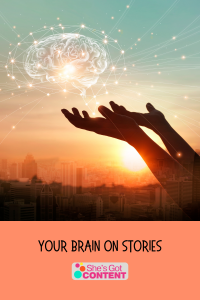Once upon a time . . .
You know a story is coming when you hear or read those words. You can easily identify a story, even when it doesn’t start with ‘once upon a time.’ That’s because your brain is wired to pay attention to stories.
Stories take you on an adventure inside your head.
Stories have served many purposes over the years. A story can be a means to entertain, educate, preserve history, or illustrate a moral lesson.
It’s through storytelling that you connect with others via the emotional impact of your story.
Your Brain On Stories
Did you know that a whole cocktail of brain chemicals is released when you listen to or read a story? As different parts of your brain become activated throughout the storytelling arc, different neurochemicals are released. Dopamine. Oxytocin. Cortisol. Endorphins. Adrenaline.
These chemicals flood your brain and your entire body. This, then, is what happens to your brain on stories.
David JP Philips, ‘Mr. Death by Powerpoint,’ explains there are actually 2 different types of neurochemical cocktails you can reliably induce in others through your marketing. He calls these two polar opposites, the Angels’ Cocktail, and the Devil’s Cocktail.
The Angels’ Cocktail
Dopamine
Oxytocin
The love hormone, oxytocin, is the second ingredient in an Angels’ Cocktail. This is the hormone responsible for feelings of generosity, trust, and bonding. It’s the same hormone released by breastfeeding mothers. Oxytocin is the hormone responsible for sealing a mother’s connection with her infant.
Telling human-experience stories helps to create empathy–the ability to feel and share the feelings of the characters in your story. This increases the connection with the storyteller. It makes the storyteller more relatable, more human.
Endorphins
Remember the term ‘runner’s high?’ Exercise is another activity that releases endorphins and makes you feel good, much like a humorous story.
The Devil’s Cocktail
The opposite of the Angels’ Cocktail is the Devil’s Cocktail. This cocktail includes cortisol and adrenaline. They’re also known as stress hormones. Very high levels of these hormones result in irritability, impaired memory, poor decision-making, intolerance/judgment, and less creativity.
Functional Storytelling
You can control the effect of your stories now. This is the idea behind what’s becoming known as functional storytelling. Do you want to serve an angel’s cocktail or the devil’s cocktail?
Storytelling 101–3 Tips
Choosing what type of story to tell to which audience can help you get better results.
To get the most from the concept of functional storytelling, follow these three techniques:
- Anyone can be a great storyteller. Believe in yourself as a storyteller.
- You have amazing stories happening to you and around you every day of your life. Capture those stories by writing them down. You can get started with any blank journal or notebook. The idea is to get down a story while you’re thinking about it.
- Organize your stories. This makes it easier to choose a particular story to create laughter (to produce endorphins), empathy (to create a connection), or intensity (producing dopamine). Index your stories so you can easily select which type of story you need. Some tools that would help you do this include Trello, Notion, and Evernote although there are many more.
Choose Stories According To Desired Hormones
In your marketing, content creation, speech writing, and conversation, you can now choose the best story so you can have more control over the hormones that are released in the brains and bodies of your audience.
Watch the Ted Talk video below with David JP Philips teaching these concepts. Pay attention to the stories he tells and how he tells them. He’s obviously a master.
Let me know in the comments below how you think this information may be able to help you as an online content creator.


Wow! Great article – I think I’m going to have to come back to it and absorb some more! I always think I don’t have very many stories – or not many worth sharing anyway.
Thank you for your comment, Patricia. Oh, we all have so many stories and even if something doesn’t seem like a ‘story’, there are so many ways to spin events and happenings that they turn into a story!! If you journal, look back through your journal–it’s full of stories!
Interesting information. You present technical facts in an easy to understand way. This definitely gives me things to think about. Thanks You!
Thank you so much for stopping by and commenting, Victoria!! You’re a masterful story-teller on your website–I definitely feel a connection to you after visiting and reading through many of your posts! 😍
Love this post and what David says about storytelling. How might I use this in my marketing and content creation… Write more stories… engage people in the story and less marketing tech. There are some elements that I need to think about and tool around within my brain. The power of the story is key. It engages the emotion and builds relationships. Thank you for sharing this!
Thank you for your comment, Katrina! I agree that the concept of pairing up a particular story to tell with what neurochemicals you want to induce in your audience is mind-blowing. It takes a while to understand the magnitude of power there and should only to be used for the greater good–only for creating win-win’s.
Wow! Thank you so much for sharing this Ted Talk. Very insiteful and interesting. Cheers
Thanks for your comment, Jenny! I am fascinated by how powerful our brain chemicals are and even more so that we can now choose different stories to produce different results in our readers’/listeners’ brains. How mind-blowing!
[…] There’s scientific evidence that stories elicit a biochemical hormone, oxytocin, in the brain … […]